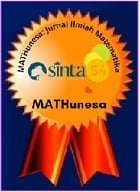PENERAPAN METODE PERAMALAN MENGGUNAKAN FUZZY ARMA
STUDI KASUS: JUMLAH WISATAWAN MANCANEGARA YANG DATANG KE JAWA BARAT
DOI:
https://doi.org/10.26740/mathunesa.v13n1.p13-24Abstract
In the modern era, forecasting has become a critical tool in strategic planning across various sectors, including tourism, which plays a significant role in the economy of West Java. Forecasting the number of international tourist arrivals is a crucial step that can influence government policies, resource allocation, and investment decisions within the tourism industry. However, the complexity of factors affecting tourist arrivals, such as global economic conditions, political situations, weather changes, and cultural events, presents unique challenges for accurate forecasting. To minimize the risks associated with forecasting errors, it is essential to employ models that can handle non-stationary data as well as data that contains uncertainty and high complexity. The ARMA ( Autoregressive Moving Average) model is commonly used for forecasting time series data that follows a normal distribution, but this model has limitations when applied to non-stationary data or data with fuzzy characteristics. As a solution, the Fuzzy ARMA model was developed to address data that not only contains uncertainty but also incorporates fuzzy characteristics. Fuzzy logic provides the flexibility to handle uncertain data by using linguistic variables and fuzzy sets, enabling the Fuzzy ARMA model to deliver more accurate forecasts compared to traditional ARMA models.This research aims to develop and apply the Fuzzy ARMA model for forecasting the number of international tourist arrivals in West Java. The research process includes collecting monthly tourist arrival data, testing data stationarity, developing the Fuzzy ARMA model, and evaluating the model's accuracy. The parameters of the Fuzzy ARMA model are estimated using the Maximum Likelihood Estimation (MLE) method with the Iteratively Reweighted Least Squares (IRLS) optimization approach.
Downloads
Downloads
Published
Issue
Section
License
Copyright (c) 2025 MATHunesa: Jurnal Ilmiah Matematika

This work is licensed under a Creative Commons Attribution-NonCommercial 4.0 International License.
 Abstract views: 506
,
Abstract views: 506
, PDF Downloads: 584
PDF Downloads: 584










